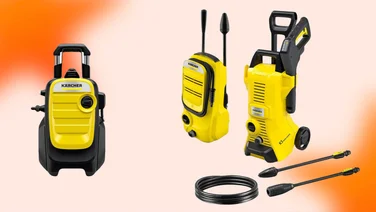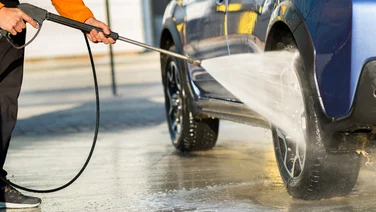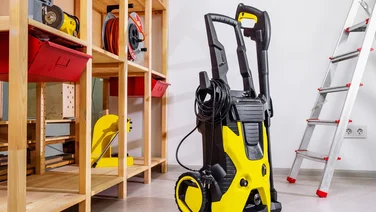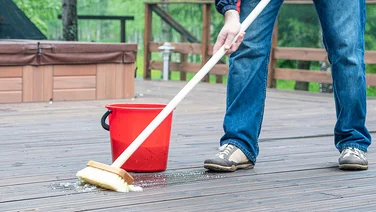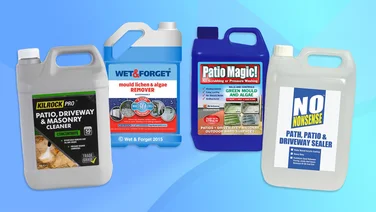To help us provide you with free impartial advice, we may earn a commission if you buy through links on our site. Learn more

When it comes to cleaning outdoor surfaces – like driveways, patios, and decking – pressure washers are highly effective and efficient tools. These incredibly powerful jets of water, with their versatile range settings and myriad attachments, can make quick work of caked-on dirt and stubborn stains, as well as mold and mildew.
However, used incorrectly, pressure washers are potentially powerful enough to damage property, and can even cause some serious injury. Whether it’s employing the wrong spray nozzle, or failing to adjust the pressure to suit the surface you’re cleaning, there are several extremely common mistakes that pressure washer users should try to avoid. Our list, below, highlights some of these basic errors, along with some expert advice from Paul Hicks, product and marketing manager at STIHL GB, and Clair Albone, a gardening specialist for Wickes.
6 common mistakes people make when pressure washing
This is our list of some of the most common mistakes people make when pressure washing, but you can check out our other guide for more information on which surfaces you should avoid pressure washing.
1. Using too much pressure
This is perhaps the most obvious and straightforward mistake you can make. It’s worth remembering that you don’t always need to use the maximum pressure to get the job done. In fact, using excessive water pressure can be bad for your surfaces, with Paul noting that “setting the pressure too high can cause lasting damage”, though he reminds us that setting your pressure “too low can mean insufficient water flow for the job and, ultimately, a poor end result”.
If you’re unsure what will be the right pressure to use on a specific surface, consult your manufacturer’s manual. Alternatively, start by test cleaning a small area on the lowest PSI (Pounds per Square Inch) setting – you can always increase the pressure as required – and use the widest spray nozzle you have available. Which takes us neatly to…
2. Using the wrong nozzle or spray setting
Choosing the right nozzle or attachment goes hand-in-hand with choosing the right pressure. Different models will come with different nozzles, lances and attachments, but all you really need to know is that the wider the nozzle angle is, the wider your pressure washer’s spray. And a wider spray will be less concentrated, hitting your target with a lower pressure and less force. Wickes’ gardening expert, Clair, gets more specific, saying, “Nozzle selection is vital: use wide fan jets for softer surfaces, narrow or rotating pencil jets for hard ones, but take care around delicate areas, like jointing sand or mortar on patios and blockwork.”
3. Spraying directly at your target
While it may be tempting to get the pressure washer nozzle right up next to the dirt or grime you’re trying to blast away, pressure washing from too close a range or at too direct an angle isn’t a good idea. For one thing, the force of such point-blank blasting will cause immense splashback, and will be far more likely to throw dirt up and spread it around than clear it away properly. But, more importantly, that kind of close, direct pressure increases the chance of damaging your surfaces. So, if you don’t want to scour your stone, strip your paint or split your decking then you should avoid doing it. Clair suggests that you “hold the lance at a 45-degree angle, approximately 30cm from the surface” for the best results.
4. Not using safety equipment
It’s easy to fall into the trap of not taking a pressure washer’s power seriously. After all, how much harm could a little water do? Well, as it turns out, quite a lot. At high pressure, the jet from a pressure washer can cut with power similar to that of a blade or a small saw, which means you could give yourself a pretty nasty injury if you’re not careful.
Paul explains the full extent of the potential dangers and the gear you will need: “When operating a pressure washer, debris, stones and dirty water can flick up towards you, so wearing a pair of safety goggles is vital to prevent serious injury. I would also recommend wearing gloves to improve your grip and protect your hands from the high water pressure and any chemicals when using a cleaning detergent. And work boots with high grip soles, which will keep you stable if the surface you’re cleaning becomes slippy when wet.”
5. Washing in the wrong sequence
It might seem like a simple thing, but pressure washing in the right direction and order is an important part of the task and, done right, can save you plenty of time and energy. For example, when washing ground-level surfaces, like stone patios, it is important to start from one side and work your way across, spraying in a sweeping motion. This will ensure you’ll catch all the dirt and debris, and move it all off of your surface. Whereas spot cleaning, or starting from the middle, will likely end with you having simply moved the dirt around a bit.
Similarly, when cleaning walls and siding, it’s a good idea to start from the top and work your way down, as dirty water will run down the surface as you clean. As Paul says, “I would also always suggest working from the top to the bottom when using a pressure washer to prevent dirt from getting onto areas that have already been cleaned.”
6. Forgetting to use detergent
If you’re a newbie, you could be forgiven for thinking that the awesome power of the pressure washer alone will be enough to scrub your surfaces completely clean. Certainly, the percussive force of the water will clear loose dirt and debris, but for deep cleaning and longer-lasting results, it’s best to use a detergent too. As Clair explains, “Detergents help to break down grime and reduce the time of cleaning with a pressure washer, but ensure you pair the detergent correctly with the surface and always opt for environmentally friendly options.”
The type of detergent you’ll need will depend on the surface you’re cleaning and the stain you’re tackling. For example, if you’re cleaning decking then you’ll need a wood-safe detergent, if you’re trying to remove oil stains then a degreasing detergent is your best bet, and so on and so forth.
If you’re unsure about the kind of detergent you should be using, consult your pressure washer’s manual for advice. It’s also a good idea to patch test the detergent on a small, inconspicuous area, to make sure there are no adverse reactions from the detergent on whichever type of surface needs cleaning.
Another useful tip worth keeping in mind is to let the detergent soak into the surface area for a few minutes, allowing it to properly break down the dirt and stains, before rinsing thoroughly.

